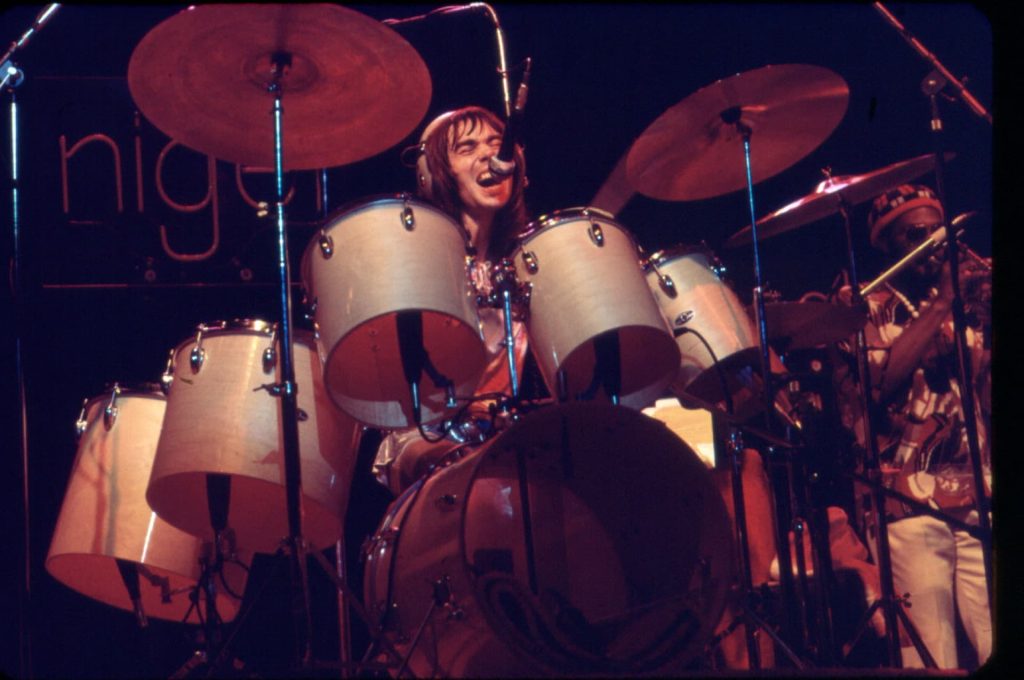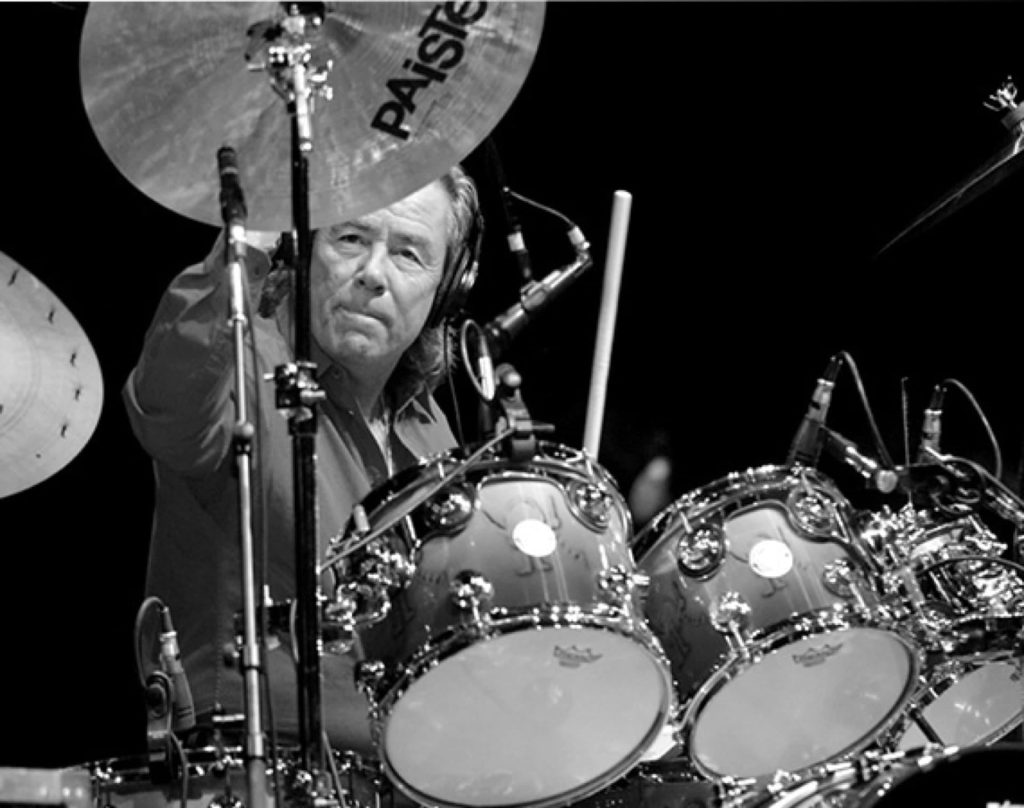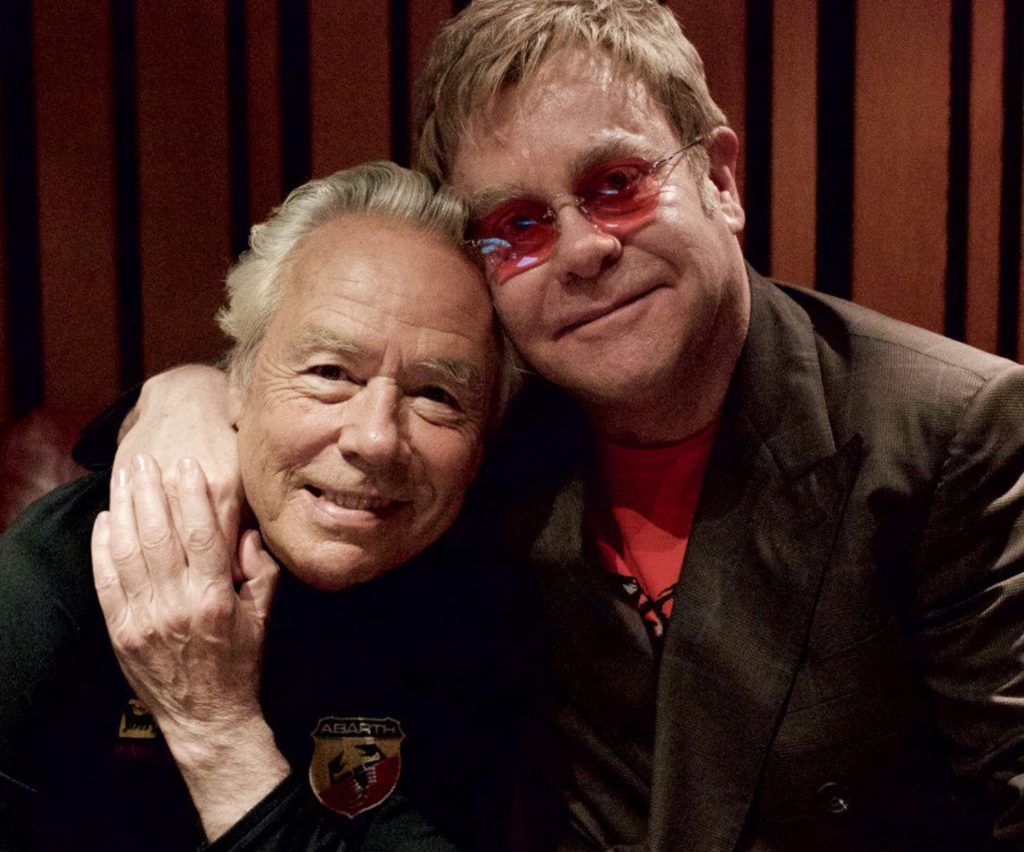Menu
Wishing Nigel Olsson a Wonderful Crazy Birthday

Nigel on stage during Elton's 1974 tour of North America.
Recently, we spoke with Nigel about being in the studio with Elton for the Wonderful Crazy Night sessions at The Village studios in Santa Monica.
Do you use a different drum set in the studio than you take on the road? Are those two different kits entirely?
Yes. The studio one obviously has more of the tonal quality. We have a special one that DW built for me… the first one that they built for me from Ghana. We only use that in the studio and we hardly ever have to put any EQ on it because it’s just set up. You put the mics on it – bang.
In the early days, it used to take us ages and ages to get a drum sound because that was Gus [Dudgeon’s] deal. You know, he needed everything so perfect. I was bashing away for hours. There’s some times Ray [Cooper] had to take over for me, just bashing to get this sound, ’cause I got worn out.
In terms of setting up the microphones on your drums, does that change between a ballad and a rock song, for example?
No. Once we have the sound, the mics placed, that’s it on every song that we cut for the album. The only thing that would change probably would be a little bit of EQ and the echo, on the board. That would be it.


What would be the most prominent thing in your headphone mix? Would it be Elton’s piano? Matt’s bass?
Well it’s basically like I use on stage. On stage I’ve got a 42-channel mixer and everything’s in stereo. I’ve got my own effects and all that kind of stuff. I listen to the low end of the piano. So the piano would be up in the mix. Elton’s vocal would be up with some echo on it. Matt is there very prominently. And then the drums would be just a little bit down so that I play a bit harder. Not that I ever hit that hard. I mean, I’ve seen drummers hit with like logs. But I have the drums set a little bit lower than everything else so I could put more of my heart into it.
Because I play to the low end of the piano and to the lyrics of the song. “Descriptive drumming,” I call it. I don’t know whether drummers do that or whether they just play to the rest of the lads’ instruments. But that’s the way I do it.
So the feel that you have for the material is instinctive. It’s not so much thinking as it is feeling.
That’s my whole thing. If you don’t have it in the first three or four takes, you’ve lost the instant surge that you get from the song. Most of Wonderful Crazy Night was cut within the first few takes. The first one was kind of getting to know the song right after Elton had written it. We didn’t rehearse the songs per se. We heard the songs being written, but we didn’t really rehearse anything. Because, especially me, I don’t like to play the songs before I go into the studio. Otherwise, it might change so much between rehearsal and getting in the studio. So I want to save all my ideas for when we were really cutting it and the tape was rolling, basically.
Do you have a basic approach? A template you might start from?
Maybe sometimes I’ll hold the time back. Sometimes I’ll go forward with it. But basically, my playing style is that I play a little bit behind the beat just to get that… It feels more emotional when you play just a little bit behind it. Especially in the ballads. With me holding it back a little bit, it gives it more movement… and especially, on my fills. I tend to do fills that aren’t too fast so that you can get the tonal quality out of the drums. It’s very hard to explain but that’s just the way I play. I hold it back.
And when I do fills, I don’t plan the fills. Obviously, after we’ve cut the record and it’s out and when we’re doing it on stage, it’s almost the same as the record. But in the studio, while we’re cutting it, I just go for the gold. I tend to…I fool the public, because they’re expecting a fill but there isn’t one and they’re like, “Ohh! Okay…” And then I’ll fling one in [at another time]. It’s just my emotions playing that song at that moment, you know?
When you and Davey, Matt and John put backing vocals on a song, do you experiment with different parts?
I was always one of the top ones, along with John. Matt is in the middle, and Davey is on the low end. I am always on the screaming end.
The Album Overall
★ Made In England was recorded over about 14 weeks in early 1994 at AIR Lyndhurst in London. Opened two years prior by the late Sir George Martin, the studio is located in a former church and is where the score for the 2019 film Rocketman was recorded.
★ The album was originally going to be called Believe. The decision to change it was made late in the day by Elton, who, after consulting with lyricist Bernie Taupin, thought it was more apropos to honour the now-title song and the fact that the album was written and recorded in his home country.
★ At the time of writing the lyrics, and into the recording sessions, all songs had one-word titles: Made In England was called England, Building A Bird was Bird, etc. Bernie and Elton both strongly wanted to evoke the single-word songs on the John Lennon/Plastic Ono Band album.
★ Elton told Greg Penny, “I want that [Lennon] vocal sound. You know, like Mother. I want this to be an album where all the songs have an interesting vocal sound and they convey something about my voice that’s a bit different.”
★ Elton’s long-time habit of doing his piano and vocal parts and then leaving everyone else to it was set aside for this album. Paul Buckmaster: “He had a lot more hands on this than any other recording I’d worked with him on. He was there for all the overdubs, all the bass parts, and guitar parts and so on.” For this reason, Elton was given co-producer credit on the album.
